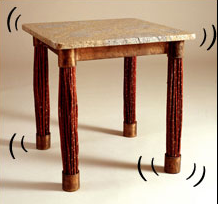I’m here at a local coffee shop, just to start the morning with my thoughts, a computer and a cup of jo. Wait…. the table wobbles! As it does, the coffee comes a little too close to one side of the cup. Are other tables available? Is there a simple fix for this one? Do I gulp down the first ¼ cup; possibly scalding myself with hot liquid, just to be sure the cup won’t spill? 
Why am I even thinking about this? Oh, don’t tell me that you haven’t encountered wobbly tables before! Or noticed the table next to you is really wobbly and silently observe how someone else deals with the situation. By the way, if you found amusement in their wobble discomfort, there is actually a German word for that psychological tendency.
Now that I think of it, how customers respond to wobbly tables may be a window into their personality. So after careful research at no less than three local coffee shops and an email exchange with a colleague* who also had a cancelled appointment Monday afternoon, I present you with
The Wobbly Table Response Indicator
Item development, scaling and validation – we can save those for another day. Let’s go right to the good stuff – interpretation! We have identified five styles of wobbly table response, some accompanied by deep insight into psychodynamic history leading to such behavioral tendencies:
Type 1 response: Denial tendency. “It’s nothing”, you say to yourself. These types refuse to let a wobbly table get the best of them to the point of ignoring even the most severe wobble. Extreme types remain in denial even as liquid drips off the table onto their lap.
Type 2 response: Fixer upper tendency. Most notable are those who put matchbooks or folded papers under the wobbly leg. Some types act out the “Princess and the pea” fairy tale, claiming they can detect wobble differences of a single sheet of paper. Even more extreme types are known to saw off the longer legs until the table no longer wobbles. These are people who should not try to trim the length of each side of their mustache on a regular basis.
Type 3 response: Easily amused tendency. The initial distraction of a wobbly table gives way to amusement and a tendency to tap out a song with the wobbliness of the table. They are often surprised by caustic comments from other customers who do not share this same tendency. Early shaping of this tendency may be observed among 5 year olds forced to occupy themselves in coffee shops while their parents talk amongst adult friends.
Type 4 response: Adaptive, highly mobile tendency. These types decidedly move from the table to table and may even evacuate the shop. Extreme types just throw out the table and are quickly recognized as people who have no tables in their homes.
Type 5 response: Earthmover tendency. Cognitively these people can see the forest for the trees and think ahead to a world without wobbly tables. In the mean time they are likely to redesign the floor to compensate for the shortcomings of the coffee table. Many are found to have lived in split-level ranch houses during their formative years. Under great stress (can’t find a way to redesign the floor), these types risk becoming manic fixer-uppers.
How do you rate yourself on the Wobbly Table Response Indicator? (Just how tightly wrapped are you anyway?)
How have your customers responded to wobbly tables? (Prize for the best story!)
BestCustomerConnection, by Marc Sokol
* Thanks to colleague Jeffrey Saltzman, who recently sent me one of his excellent books suggesting that, if I didn’t like it, at least it could be used to stabilize a wobbly table. The book is great!





